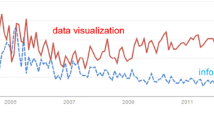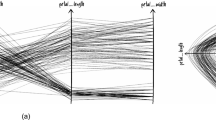Abstract
The aim of this paper is to propose a Vector Space Model as a new methodological approach which allows us to present the relationships between the elements of the Triple Helix Model (University, Industry, Government) in a spacial model by using the webpages of the National Research Councils of Germany and Spain as examples. Outlinks of the Biomedicine and Biology centres of these national councils were analysed with the intention of representing graphically these relationships through the Vector Space Model that allows for Multidimensional Scaling in three dimensions. Results show a map with the differences and similarities between the Spanish and German cases. It may be concluded that these results could become a qualitative indicator of a scientific and technical reality.
Similar content being viewed by others
References
BUSQUIN, Ph., Sixth Framework Programme (2002-2006): European research steers a new course. RTD Info, Magazine for European Research, 33, April 2002.
VIALe, R., CHIGLIONE, B., The Triple Helix model: a Tool for the study of European regional socio economic systems. The IPTS Report, 29 Nov. 1998.
ETZKOWITZ, H., LeYDeSDORFF, L., The Triple Helix university-industry-government relations: A laboratory for knowledge based economic development, EASST Review, 14 (1) (1995) 14-19.
BELLAVISTA, J., Políticas para la ciencia, la tecnología y la innovación: reflexiones de actualidad para el cambio de milenio, In: MEDINA, M., KWIATKOWSNKA, T. (Eds), Ciencia, Tecnología /Naturaleza, Cultura en el siglo XXI, Anthropos, Barcelona, 2000.
ETZKOWITZ, H., Technology Centers and Industrial Policy: The Emergence of the Interventionist State in the USA, Science and Public Policy, 21 (2) (1994) 79-87.
LeYDeSDORFF, L., CURRAN, M., Mapping university-industry-government relations on the Internet: the construction of indicators for a knowledge-based economy. Cybermetrics, 4 (2000) No. 1 <http://www.cindoc.csic.es/cybermetrics/articles/v4i1p2.html>
BOUDOURIDeS, M. A., SIGRIST, B., ALeVIZOS, P. D., Webometrics and the self-organization of the european information society. Draft Report, Task 2.1 of the SOEIS Project, Rome Meeting, June 17-19, 1999.
WISER CONSORTIUM, WISER-Web Indicators for Science, Technology & Innovation Research. [s. 1.: WISER], 2002 <http://www.webindicators.org>
LeYDeSDORFF, L., SCHARNHORST, A., Measuring the Knowledge Base: A Program of Innovation Studies. Report to the Bundesministerium für Bildung und Forschung, Berlin-Brandenburgische Akademie der Wissenschaften, 2002.
ABRAHAM, R. H., Webometry: measuring the complexity of the World Wide Web. World Futures, 50 (1997) 785-791. <http://www.ralph-abrahams.org>
ABRAHAM, R. H., 1996, <http://www.ralph-abrahams.org>
BOUDOURIDeS, M. A., ANTYPAS, G. P., A Simulation of the Structure of the World-Wide Web. First Draft, 2001.
ROUSSEAU, R., Sitations: an exploratory study. Cybermetrics, 1 (1997) No. 1, <http://www.cindoc.csic.es/cybermetrics/articles/v1i1p1.html>
THELWALL, M., HARRIES, G., The connection between the research of a university and counts of links to its Web pages: An investigation based upon a classification of the relationships of pages to the research of the host university. Journal of the American Society for Information Science and Technology, (2003, to appear).
WILKINSON, D., HARRIES, G., THELWALL, M., PRICE, E., Motivations for academic Web site interlinking: Evidence for the Web as a novel source of information on informal scholarly communication, Journal of Information Science, 29 (1) (2003) 59-66.
ALMIND, T. C., INGWERSEN, P., Informetric analyses on the World Wide Web: methodological approaches to "Webometrics". Journal of Documentation, 53 (4) (1997) 404-426.
SMITH, A., ANZAC webometrics [on line]: exploring Australasian Web structures. In: Proceedings of Information Online and On Disc 99: Strategies for the next millennium. Sydney, Australia, 19-21 January 1999. [Sydney], ALIA, pp. 159-181. <http://www.csu.edu.au/special/online99/proceedings99/203b.htm
SMALL, H., Co-citation in the scientific literature: a new measure of the relationship between two documents, Journal of the American Society for Information Science, 24 (4) (1973) 265-269.
LARSON, R. R., Bibliometrics of the World Wide Web: An Exploratory Analysis of the Intellectual Structure of Cyberspace [on line] University of California, Berkeley, 1996. <http://sherlock.berkeley.edu/asis96/asis96.html>
SALTON, G., MCGILL, M., Introduction to Modern Information Retrieval. New York: McGraw-Hill, 1983.
MAX-PLANCK-INSTITUT FüR GESELLSCHAFT (Germany), Max Planck Institutes. [Berlin: MPG] [cited: 16-12-02] <http://www.mpg.de/english/institut/?Sprache=E&SelSektion=BM&SelName= A-Z&SelRegion=*&SelSort=Name&Submit.x=23&Submit.y=12>
CONSEJO SUPERIOR De INVESTIGACIONES CIENTIFICAS (Spain) CSIC, Área de Biología y Biomedicina. [Madrid: CSIC] [cited: 16-12-02]. <http://www.csic.es/hispano/area2.htm>
SENKER, J., BALAZS, K., HIGGINS, T., LAREDO, P., MUNOZ, E., SANTESMASES, M., ESPINOSA De LOS MONTEROS, J., POTI, B., REALe, E., DI MARCHI, M., SCARDA, A., SANDSTROM, U., SCHIMANK, U., WINNES, M., SKOIE, H., THORSTEINSDOTTIR, H., European Comparison of Public Research Systems. TSER Project No. SOE1-CT96-1036 Changing Structure, Organisation and Nature of European PSR Systems, 1999.
CyberSpider Link Text [on-line] Ver. 2.1.18 [Canada]: Aman Software, c1996-2002. Software.
YOUNG, F. W., ViSta: The Visual Statistic System. [on line] Ver. 5.0.5EW [North Carolina]: UNC, c1991-1998. 3,87 Mb. Software. <http://forrest.psych.unc.edu/research>
BöRNER, K., CHEN, CH., BOYACK, K., Visualizing knowledge domains. Annual Review of Information Science & Technology, 37 (2003) (in press).
SALTON, G., The Smart Retrieval System-Experiments in Automatic Document Processing, Prentice-Hall, Englewood Cliffs, New York, 1971.
ORTEGA PRIEGO, J. L., Análisis de referencias basado en un Modelo de Espacios Vectoriales: la investigación en Historia Contemporánea en Jaén durante 1990-1995. Revista Española de Documentación Científica. 24 (4) (2001) 369-381.
LARSEN, B., INGWERSEN, P., The Boomerang Effect: Retrieving Scientific Documents via the Network of References and Citations. SIGIR.02, August 11-15, 2002 Tampere, Finland.
WHITE, H. D., GRIFFITH, B. C., Author cocitation: a literature measure of intellectual structure. Journal of the American Society for Information Science, 32 (3) (1981) 163-171.
YOUNG, F. W., Multidimensional scaling. In: KOTZ, S., JOHNSON, N. L., READS, C. B. (Eds), Encyclopedia of Statistical Sciences. New York: John Wiley & Sons, 1985, vol. V.
TORGERSON, W. S., Multidimensional scaling: Theory and method. Psychometrika, 17 (1952) 401-419.
KRUSKAL, J. B., Nonmetric multidimensional scaling. Psychometrika, 29 (1964) 115-129.
BARJAK, F., HARABI, N., The Internet for R&D. SIBIS (Statistical Indicators Benchmarking the Information Society) Project IST-2000-26276 Topic research and indicator development, 2001.
NOYONS, E., Bibliometric mapping of science in a policy context. Scientometrics, 50 (1) (2001) 83-98.
AGUILLO, I. F., PAREJA, V. M., Indicators of the Internet presence of the Western European Research Councils. In: Poster Presentation in S&T 2000, Leiden, May 2000 [on line]. <http://sahara.fsw.leidenuniv.nl/cwts/abs/AGUILLO.txt>
Author information
Authors and Affiliations
Corresponding author
Rights and permissions
About this article
Cite this article
Priego, J.L.O. A Vector Space Model as a methodological approach to the Triple Helix dimensionality: A comparative study of Biology and Biomedicine Centres of two European National Research Councils from a Webometric view. Scientometrics 58, 429–443 (2003). https://doi.org/10.1023/A:1026201013738
Issue Date:
DOI: https://doi.org/10.1023/A:1026201013738




